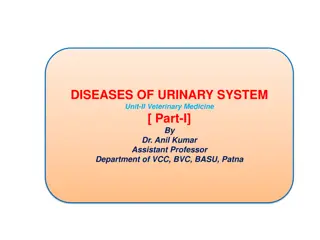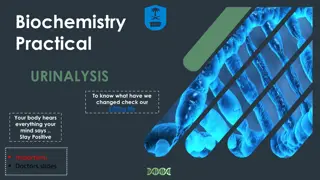Understanding Urinary Elimination: Anatomy, Physiology, and Function of the Kidneys
The lecture covers the fundamentals of urinary elimination focusing on the kidneys' location, structure, function, and the role of nephrons. It discusses the transport of urine through the ureters to the bladder, highlighting the bladder's muscle layers and the urethra's role in expelling urine. Stu
2 views • 37 slides
An Overview of the Renal System and Nephron Anatomy
The renal system consists of the kidneys, ureters, urinary bladder, and urethra, responsible for producing, transporting, storing, and excreting urine. The kidneys are surrounded by three layers, and the nephron is the functional unit responsible for filtering blood and producing urine. Key componen
4 views • 26 slides
Exploring the Composition of Earth's Oceans
Delve into the composition, location, and subsurface topography of the world's oceans, discovering the chemical makeup of ocean water and its vast salt content. Uncover fascinating facts such as how the salt in the oceans could create a 500-foot thick layer if spread over Earth's land surface. Engag
1 views • 16 slides
Understanding Urinalysis: Importance and Interpretation
Urinalysis is a crucial diagnostic test used to detect various disorders like infections, kidney diseases, and diabetes by examining the physical, chemical, and microscopic properties of urine. It involves assessing color, specific gravity, and chemical content, such as pH and protein levels. The in
0 views • 22 slides
Principles of Architecture: Unity, Contrast, Mass Composition
Explore the fundamental principles of architecture focusing on unity, contrast, and mass composition. Unity emphasizes harmony among building elements, contrast adds interest without disrupting unity, and mass composition involves arranging shapes in a harmonious way. Proportion and scale play key r
0 views • 24 slides
Understanding Atmosphere Composition and Structure in Climatology
The study of climatology, focusing on the atmosphere, is presented by Dr. Banashree Saikia, covering topics such as atmospheric composition, insolation, temperature variations, atmospheric pressure, wind systems, atmospheric moisture, climatic classification, cyclones, and monsoons. The atmosphere,
1 views • 9 slides
Understanding Urinary System Function in Veterinary Medicine
The urinary system in veterinary medicine involves the anatomy and physiological functions of maintaining body fluid composition and volume. Key processes like urine production, filtration, reabsorption, and regulation through nephrons play vital roles in maintaining overall health. This article cov
0 views • 14 slides
Understanding Urinalysis: Importance and Interpretation of Urine Analysis Parameters
Urinalysis is a crucial diagnostic tool that provides valuable insights into various health conditions through the examination of urine physical and chemical properties. This examination helps in detecting abnormalities such as diabetes, renal failure, dehydration, and infections. By understanding t
1 views • 11 slides
Veterinary Anatomy of Urinary System in Different Animals
The urinary system in animals includes kidneys, ureters, and the bladder, all crucial for filtration and urine excretion. The ureters are excretory ducts from the kidneys, while the bladder stores urine before expulsion. Various diagrammatic structures illustrate the urogenital system of animals, pa
0 views • 20 slides
Nutritive Value and Composition of Eggs by Dr. Sushma Kumari
The composition and nutritive value of eggs, as presented by Dr. Sushma Kumari from Bihar Animal Sciences University, cover various aspects including the physical composition of eggs, the composition of an eggshell, and the chemical composition of eggs. The presentation delves into details such as t
0 views • 19 slides
Understanding the Composition of Earth's Interior: Insights from Density, Pressure, and Temperature
The constitution of the Earth's interior plays a crucial role in shaping the surface features we observe. Although direct observation is challenging, seismic studies offer valuable insights. The density, pressure, and temperature within the Earth provide essential clues to its composition. Rocks' de
0 views • 14 slides
Understanding Mechanisms for Concentrating & Diluting Urine in Maintaining ECF Osmolarity
Explore the intricate processes involved in concentrating and diluting urine to regulate extracellular fluid (ECF) osmolarity through mechanisms like the loop of Henle and vasa recta. Understand the factors influencing the ability to create a concentrated medullary gradient, differentiate water diur
0 views • 26 slides
Understanding Environmental Hygiene: Air Pollution and Composition of Air
The content delves into the concept of atmospheric pollution, the composition of pure and impure air, sources of air pollution, and the zones of the atmosphere. It highlights the detrimental effects of pollutants on health and the environment, emphasizing the importance of environmental hygiene. The
1 views • 27 slides
Understanding Alcohol Absorption, Elimination, and Units: A Comprehensive Overview
Alcohol, specifically ethanol, is absorbed through the stomach and intestines into the bloodstream within minutes, and it is primarily eliminated through breath, sweat, urine, and the liver. The concept of a unit of alcohol helps in calculating safe consumption levels, with factors like volume and a
3 views • 16 slides
Understanding Moles and Formula Mass in Chemistry
Dive into the world of moles, Avogadro's number, and formula mass calculations in chemistry. Learn how to convert moles to grams, grams to moles, and determine the number of atoms using Avogadro's number. Explore the concepts of formula mass and percentage composition to understand the composition o
0 views • 19 slides
**Wisconsin Healthcare-Associated Infections in LTC Coalition: Urine Testing Guidelines**
The Wisconsin Healthcare-Associated Infections in LTC Coalition provides guidelines on when to test and submit urine specimens for testing in long-term care facilities. The focus is on reducing unnecessary urine testing, introducing tools like the UTI Stoplight Tool and the When To Test-Nursing Tool
5 views • 16 slides
Understanding General Urine Examination and Stool Examination
General urine examination involves analyzing the color, clarity, and chemical composition of urine, providing insights into various health conditions and potential issues. It helps in detecting metabolic disorders, kidney diseases, and drug abuse. Additionally, the general stool examination is essen
0 views • 37 slides
Understanding Butter: Definition, Standards, and Composition
Explore the definition of butter according to FSSAI standards, including its composition, permitted additives, and classifications based on acidity, salt content, end-use, and manufacturing practices. Discover the nutritional composition and fatty acid profile of butter along with essential informat
0 views • 10 slides
Understanding Nephritis: Causes, Symptoms, and Subtypes
Nephritis is a serious medical condition characterized by inflammation of the nephrons in the kidneys. This inflammation can lead to various subtypes such as glomerulonephritis and interstitial nephritis, each with its own causes and symptoms. Common symptoms of nephritis include edema, changes in u
0 views • 26 slides
Analysis of Urine Composition in Volunteers Under Various Conditions
This study involved measuring the volume and composition of urine from four groups of volunteers under different conditions: control, water intake, saline intake, and Lasix administration. The data recorded included urine volume, osmolality, pH, Na+ concentration, flow rate, and Na+ excretion rate,
0 views • 18 slides
Common Laboratory Techniques in Zoology - Urine and Stool Specimen Analysis
In the Biology Department at Al-Mustansiriyah University, students learn laboratory techniques for collecting and analyzing urine and stool specimens. The process involves random urine sample collection, urine tests for chemical components, urine culture, stool specimen analysis for pathological con
0 views • 10 slides
Secure Composition of Key Exchange Protocols
Explore the game-based composition approach for key exchange protocols, focusing on ensuring security in compositions with arbitrary tasks and the universal composability of protocols. Delve into the Bellare-Rogaway security model and the details of security games in protocol analysis. Understand ke
0 views • 25 slides
Understanding Chemistry and Composition in the Climate System
Dive into the intricate relationship between chemistry and composition in the climate system, exploring topics such as radiative effects, stratosphere-troposphere coupling, aerosol-cloud interactions, and the impact of various gases and particulates on radiative forcing. Discover how changes in comp
0 views • 25 slides
Reflex Urine Culturing in UTI Diagnosis: Dos and Don'ts
Reflex urine culturing is a crucial diagnostic strategy for UTIs in hospitalized patients, emphasizing the importance of suspicion over urinalysis. Misuse can lead to increased positive cultures. Understanding the relevance to SPARC and focusing on diagnostic stewardship can help prevent unnecessary
0 views • 21 slides
Understanding Urine Concentration Mechanisms in the Renal System
The lecture covers the concepts of urine concentration and dilution in the renal system, focusing on the loop of Henle and countercurrent multiplier and exchange systems. It discusses how the loop of Henle reabsorbs salt and water to determine urine osmolarity, factors influencing medullary gradient
0 views • 20 slides
Soil Chemistry and Mineralogy Analysis at CSU Summer Soil Institute
Explore the comprehensive analysis of soil chemistry, texture, and mineralogy conducted at the CSU Summer Soil Institute in July 2010. The study delves into pedology, elemental composition, particle size distribution, X-ray diffractometry, and mineralogical composition of various soil samples. Detai
0 views • 22 slides
Kidney Stone Treatment in Pune with Dr Abhijit Gokhale
Kidney stones are solid crystals formed from the salts in urine. They are sometimes called renal calculi. Kidney stones can block the flow of urine and cause infection, kidney damage or even kidney failure. They can vary in size and location.\n
0 views • 4 slides
Understanding Maple Syrup Urine Disease and Albinism
Maple Syrup Urine Disease (MSUD) is a metabolic disorder affecting the breakdown of branched-chain amino acids, leading to severe symptoms like physical and mental retardation, sweet-smelling urine, and metabolic acidosis. Treatment involves dietary restrictions and potential gene therapy. Albinism,
0 views • 16 slides
Understanding Percentage Composition in Chemistry
Percentage composition is crucial in determining the elemental composition of compounds. This lesson explains how to calculate percentage composition using molar masses, illustrated with examples like copper sulfide. It also delves into hydrated salts and their significance in chemistry. Students wi
0 views • 22 slides
Optimization of Laser-Based Surface Analysis Diagnostics for 2021 Tasks
The focus is on optimizing laser-based surface analysis diagnostics, including LIBS development, D-retention monitoring, and absolute quantification of D and composition in various layers. Tasks for 2021 include line separation challenges, depth resolution studies, CF-LIBS improvements, and machine
0 views • 7 slides
Understanding and Efficiently Managing Urine-Diverting Dry Toilets (UDDT) Systems
This detailed guide explores the principles and practices of using Urine-Diverting Dry Toilets (UDDT), focusing on their construction, usage, and maintenance. Learn about the benefits, challenges, common mistakes to avoid, and essential tips for optimizing UDDT performance. From understanding the ty
0 views • 20 slides
Pediatric Pharmacology Considerations and Challenges
Developmental pharmacology in children involves unique considerations such as drug metabolism, urine concentration, and muscle relaxant dosing. The field faces challenges with limited drug testing in pediatric populations, emphasizing the importance of age-appropriate pharmacotherapy. Factors like d
0 views • 39 slides
Understanding Composition in Art: Techniques and Examples
Explore the concept of composition in art through various styles such as abstract, naturalistic, and stylized representations. Learn about the vocabulary and skills necessary for effective composition, with examples from renowned artists like Leonardo da Vinci, Georges Seurat, and more. Discover how
0 views • 43 slides
Understanding Diabetes Insipidus: Types, Causes, and Symptoms
Diabetes insipidus (DI) is a disorder caused by a deficiency of anti-diuretic hormone (ADH), leading to the excessive passage of diluted urine. Central DI results from pituitary or hypothalamus issues, while nephrogenic DI occurs when the kidneys fail to respond to ADH. Common causes include brain t
0 views • 22 slides
Analytical Toxicology: Techniques and Sample Analysis in Clinical Toxicology
Analytical toxicology involves the observation, identification, and measurement of foreign compounds in biological and other samples, such as urine, blood, stomach contents, nails, hair, and DNA. Various techniques are used to isolate and identify drugs and poisons present in these samples. This fie
0 views • 12 slides
Utilizing Different Samples for Diagnostic Testing in Medicine
The practice of diagnostic testing in medicine goes beyond blood and stool samples. Gathering urine samples, for example, allows healthcare providers to assess various health aspects, such as kidney function, urinary tract infections, diabetes, and more. By examining the color, clarity, odor, densit
0 views • 21 slides
Understanding the Human Urinary System
The human urinary system consists of the kidneys, ureters, bladder, and urethra. The kidneys filter blood to produce urine, which is carried to the bladder through the ureters for storage until excretion. Each kidney is structured with renal pyramids and nephrons for blood filtration and waste remov
0 views • 16 slides
Understanding Renal Physiology and Functions
This content covers the aims of studying renal physiology, functions of the kidney, basic renal processes, renal secretion, urine formation, and types of renal failure. It delves into topics such as water balance, electrolyte balance, urine production, and the components of the urinary system. The i
0 views • 10 slides
Understanding General Urine Examination
General Urine Examination involves analyzing waste products, collection of urine specimens, factors affecting urine amount, preservation methods, physical examination characteristics like color and transparency, specific gravity, odor, and chemical properties including pH, protein, glucose levels. I
0 views • 13 slides
Laboratory Diagnosis of Parasites: Methods and Clinical Specimens
Laboratory diagnosis of parasitic infections involves techniques such as demonstration of parasites, immunodiagnosis, and molecular biological methods. Clinical specimens for diagnosis include blood, urine, genital specimens, sputum, and tissue biopsy/aspiration. Chyluria, a condition with milky whi
0 views • 24 slides







































